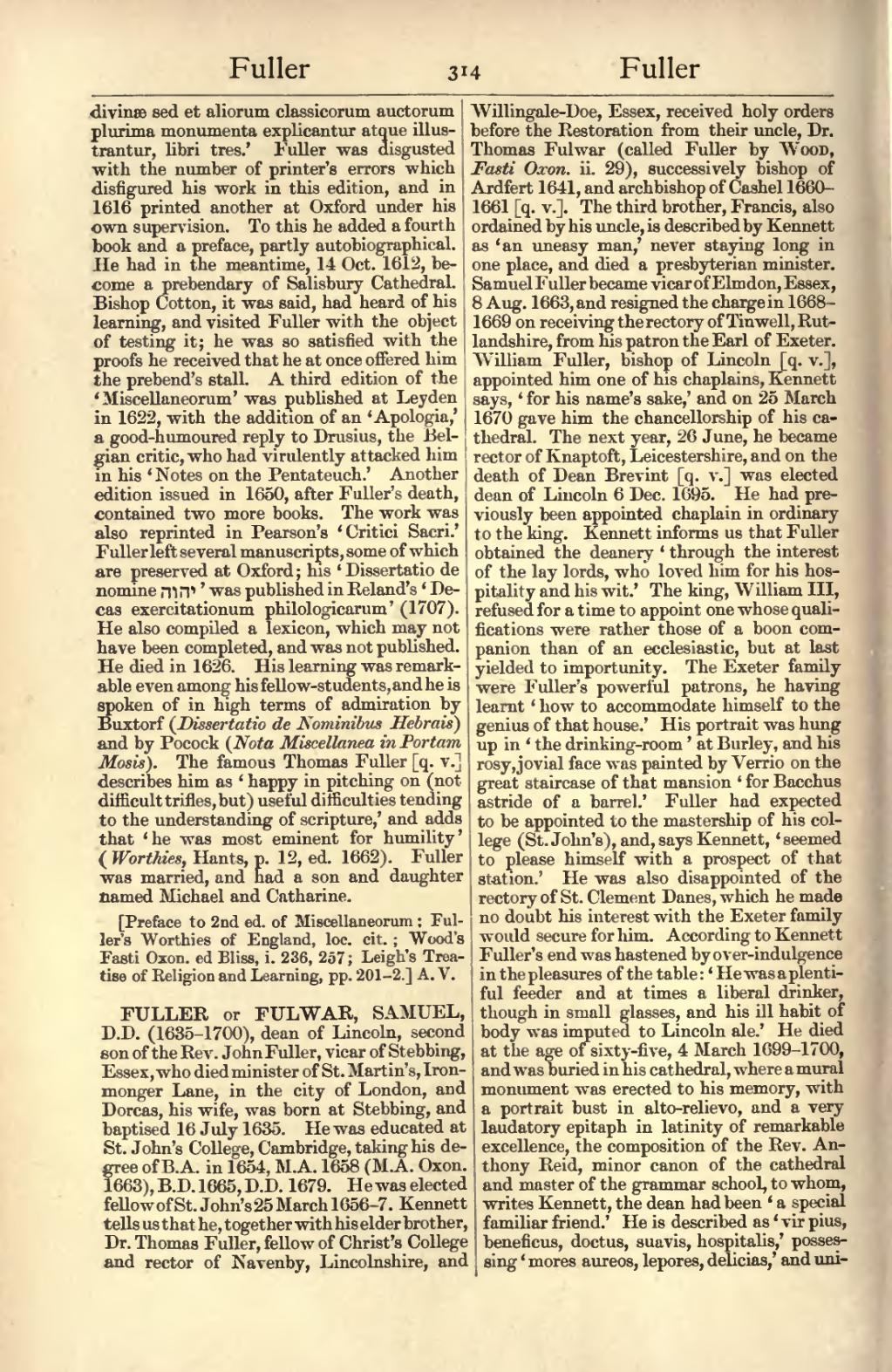divinæ sed et aliorum classicorum auctorum plurima monumenta explicantur atque illustrantur, libri tres.' Fuller was disgusted with the number of printer's errors which disfigured his work in this edition, and in 1616 printed another at Oxford under his own supervision. To this he added a fourth book and a preface, partly autobiographical. He had in the meantime, 14 Oct. 1612, become a prebendary of Salisbury Cathedral. Bishop Cotton, it was said, had heard of his learning, and visited Fuller with the object of testing it; he was so satisfied with the proofs he received that he at once offered him the prebend's stall. A third edition of the 'Miscellaneorum' was published at Leyden in 1622, with the addition of an 'Apologia,' a good-humoured reply to Drusius, the Belgian critic, who had virulently attacked him in his 'Notes on the Pentateuch.' Another edition issued in 1650, after Fuller's death, contained two more books. The work was also reprinted in Pearson's 'Critici Sacri.' Fuller left several manuscripts, some of which are preserved at Oxford; his 'Dissertatio de nomine יהוה' was published in Reland's 'Decas exercitationum philologicarum' (1707). He also compiled a lexicon, which may not have been completed, and was not published. He died in 1626. His learning was remarkable even among his fellow-students, and he is spoken of in high terms of admiration by Buxtorf (Dissertatio de Nominibus Hebrais) and by Pocock (Nota Miscellanea in Portam Mosis). The famous Thomas Fuller [q. v.] describes him as 'happy in pitching on (not difficult trifles, but) useful difficulties tending to the understanding of scripture,' and adds that 'he was most eminent for humility' (Worthies, Hants, p. 12, ed. 1662). Fuller was married, and had a son and daughter named Michael and Catharine.
[Preface to 2nd ed. of Miscellaneorum; Fuller's Worthies of England, loc. cit.; "Wood's Fasti Oxon. ed Bliss, i. 236, 257; Leigh's Treatise of Religion and Learning, pp. 201-2.]
FULLER or FULWAR, SAMUEL, D.D. (1635–1700), dean of Lincoln, second son of the Rev. John Fuller, vicar of Stebbing, Essex, who died minister of St. Martin's, Ironmonger Lane, in the city of London, and Dorcas, his wife, was born at Stebbing, and baptised 16 July 1635. He was educated at St. John's College, Cambridge, taking his degree of B.A. in 1654, M.A. 1658 (M.A. Oxon. 1663), B.D. 1665, D.D. 1679. He was elected fellow of St. John's 25 March 1656–7. Kennett tells us that he, together with his elder brother, Dr. Thomas Fuller, fellow of Christ's College and rector of Navenby, Lincolnshire, and Willingale-Doe, Essex, received holy orders before the Restoration from their uncle, Dr. Thomas Fulwar (called Fuller by Wood, Fasti Oxon. ii. 29), successively bishop of Ardfert 1641, and archbishop of Cashel 1660–1661 [q. v.] The third brother, Francis, also ordained by his uncle, is described by Kennett as ‘an uneasy man,’ never staying long in one place, and died a presbyterian minister. Samuel Fuller became vicar of Elmdon, Essex, 8 Aug. 1663, and resigned the charge in 1668–1669 on receiving the rectory of Tinwell, Rutlandshire, from his patron the Earl of Exeter. William Fuller, bishop of Lincoln [q. v.], appointed him one of his chaplains, Kennett says, ‘for his name's sake,’ and on 25 March 1670 gave him the chancellorship of his cathedral. The next year, 26 June, he became rector of Knaptoft, Leicestershire, and on the death of Dean Brevint [q. v.] was elected dean of Lincoln 6 Dec. 1695. He had previously been appointed chaplain in ordinary to the king. Kennett informs us that Fuller obtained the deanery ‘through the interest of the lay lords, who loved him for his hospitality and his wit.’ The king, William III, refused for a time to appoint one whose qualifications were rather those of a boon companion than of an ecclesiastic, but at last yielded to importunity. The Exeter family were Fuller's powerful patrons, he having learnt ‘how to accommodate himself to the genius of that house.’ His portrait was hung up in ‘the drinking-room’ at Burley, and his rosy, jovial face was painted by Verrio on the great staircase of that mansion ‘for Bacchus astride of a barrel.’ Fuller had expected to be appointed to the mastership of his college (St. John's), and, says Kennett, ‘seemed to please himself with a prospect of that station.’ He was also disappointed of the rectory of St. Clement Danes, which he made no doubt his interest with the Exeter family would secure for him. According to Kennett Fuller's end was hastened by over-indulgence in the pleasures of the table: ‘He was a plentiful feeder and at times a liberal drinker, though in small glasses, and his ill habit of body was imputed to Lincoln ale.’ He died at the age of sixty-five, 4 March 1699–1700, and was buried in his cathedral, where a mural monument was erected to his memory, with a portrait bust in alto-relievo, and a very laudatory epitaph in latinity of remarkable excellence, the composition of the Rev. Anthony Reid, minor canon of the cathedral and master of the grammar school, to whom, writes Kennett, the dean had been ‘a special familiar friend.’ He is described as ‘vir pius, beneficus, doctus, suavis, hospitalis,’ possessing ‘mores aureos, lepores, delicias,’ and uni-
